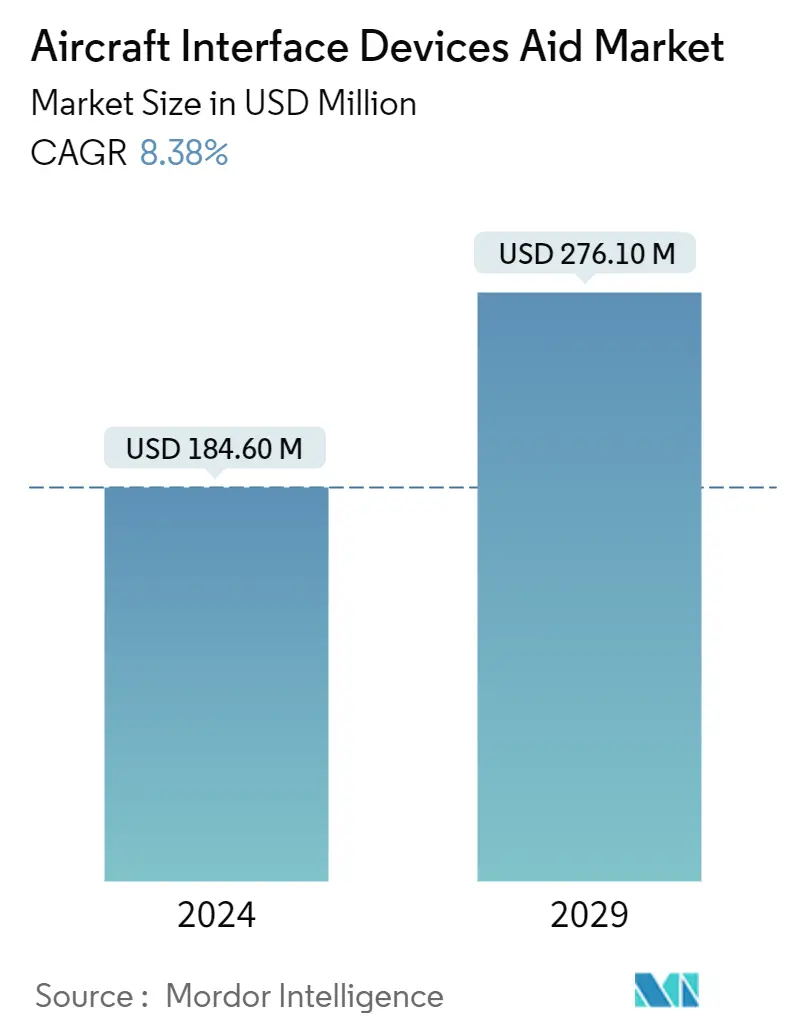Market Size of Aircraft Interface Devices Aid Industry

| Study Period | 2019 - 2029 |
| Market Size (2024) | USD 184.60 Million |
| Market Size (2029) | USD 276.10 Million |
| CAGR (2024 - 2029) | 8.38 % |
| Fastest Growing Market | Asia Pacific |
| Largest Market | North America |
| Market Concentration | High |
Major Players
*Disclaimer: Major Players sorted in no particular order |
Aircraft Interface Device Market Analysis
The Aircraft Interface Devices Aid Market size is estimated at USD 184.60 million in 2024, and is expected to reach USD 276.10 million by 2029, growing at a CAGR of 8.38% during the forecast period (2024-2029).
The growing aircraft procurement in the commercial and general aviation sectors is currently driving the market revenues. Developments in aircraft health management systems and the growing emphasis on predictive maintenance may boost the growth of the aircraft interface device market. Another reason for the growth in usage of aircraft interface devices is the need to improve the safety and efficiency of the aircraft.
- A few limitations can hamper the development of the aircraft interface device (AID) industry. The high initial cost of aircraft interface device (AID) system deployment, which includes the price of hardware, software, installation, and integration, is one major barrier. For small and medium-sized firms with limited resources, this might not be easy. Additionally, the difficult certification process for AIDs, which necessitates adherence to exacting aviation rules and standards, may provide challenges and cause delays in the deployment of AID systems.
Aircraft Interface Device Industry Segmentation
Aircraft interface devices (AIDs) enable the data transfer between the electronic flight bags (EFBs) in an aircraft and the aircraft database. AIDs are hardware platforms aboard the aircraft.
The aircraft interface devices market is segmented by application and geography. By application, the market is divided into commercial, military, and general aviation. By geography, the market is segmented into North America, Europe, Asia-Pacific, Latin America, and Middle East and Africa.
For each segment, the market size is provided in terms of value (USD).
| Application | |
| Commercial | |
| Military | |
| General Aviation |
| Geography | |||||||
| |||||||
| |||||||
| |||||||
| |||||||
|
Aircraft Interface Devices Aid Market Size Summary
The aircraft interface device market is experiencing significant growth, driven by increased aircraft procurement in the commercial and general aviation sectors. This growth is further supported by advancements in aircraft health management systems and a heightened focus on predictive maintenance, which enhance the safety and efficiency of aircraft operations. Despite these positive trends, the market faces challenges such as the high initial costs associated with the deployment of aircraft interface devices, including hardware, software, installation, and integration expenses. Additionally, the stringent certification processes required to meet aviation regulations can pose obstacles, particularly for smaller firms with limited resources.
The commercial aircraft segment is currently the dominant force in the market, propelled by the rising demand for new-generation aircraft. Aircraft interface devices are becoming increasingly integral to modern commercial aircraft, facilitating the transition from paper-based charts to digital screens in cockpits. This shift allows for improved access to aircraft data and real-time performance monitoring, which can enhance flight planning and reduce operating costs. The Asia-Pacific region is expected to be the fastest-growing market, driven by rapid increases in air passenger traffic and substantial aircraft procurement in countries like China and India. Prominent industry players, including Astronics Corporation, THALES, and Collins Aerospace, are competing intensely to innovate and capture new market opportunities, particularly in the military sector.
Aircraft Interface Devices Aid Market Size - Table of Contents
-
1. MARKET DYNAMICS
-
1.1 Market Overview
-
1.2 Market Drivers
-
1.3 Market Restraints
-
1.4 Industry Attractiveness - Porter's Five Forces Analysis
-
1.4.1 Threat of New Entrants
-
1.4.2 Bargaining Power of Buyers/Consumers
-
1.4.3 Bargaining Power of Suppliers
-
1.4.4 Threat of Substitute Products
-
1.4.5 Intensity of Competitive Rivalry
-
-
-
2. MARKET SEGMENTATION
-
2.1 Application
-
2.1.1 Commercial
-
2.1.2 Military
-
2.1.3 General Aviation
-
-
2.2 Geography
-
2.2.1 North America
-
2.2.1.1 United States
-
2.2.1.2 Canada
-
-
2.2.2 Europe
-
2.2.2.1 United Kingdom
-
2.2.2.2 Germany
-
2.2.2.3 France
-
2.2.2.4 Italy
-
2.2.2.5 Rest of Europe
-
-
2.2.3 Asia-Pacific
-
2.2.3.1 China
-
2.2.3.2 Japan
-
2.2.3.3 India
-
2.2.3.4 South Korea
-
2.2.3.5 Rest of Asia-Pacific
-
-
2.2.4 Latin America
-
2.2.4.1 Brazil
-
2.2.4.2 Mexico
-
2.2.4.3 Rest of Latin America
-
-
2.2.5 Middle-East and Africa
-
2.2.5.1 United Arab Emirates
-
2.2.5.2 Saudi Arabia
-
2.2.5.3 Egypt
-
2.2.5.4 Qatar
-
2.2.5.5 Rest of Middle-East and Africa
-
-
-
Aircraft Interface Devices Aid Market Size FAQs
How big is the Aircraft Interface Devices Aid Market?
The Aircraft Interface Devices Aid Market size is expected to reach USD 184.60 million in 2024 and grow at a CAGR of 8.38% to reach USD 276.10 million by 2029.
What is the current Aircraft Interface Devices Aid Market size?
In 2024, the Aircraft Interface Devices Aid Market size is expected to reach USD 184.60 million.

